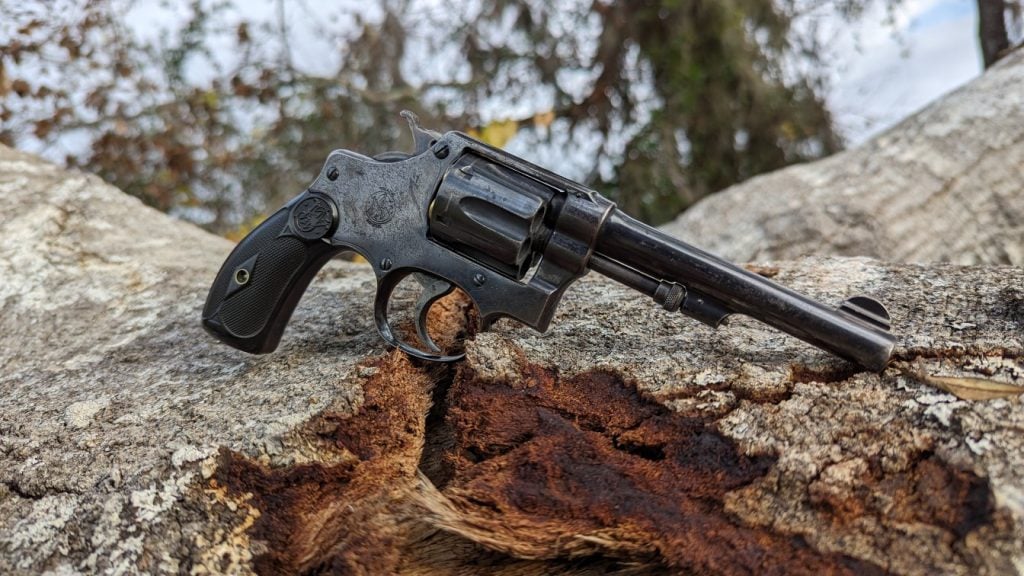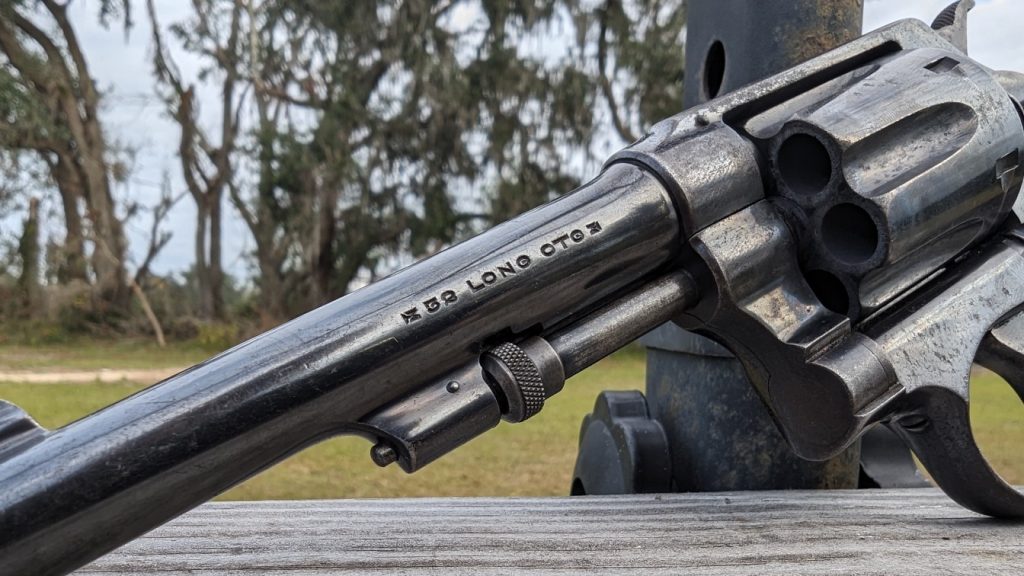When you try to find the first of something, you’ll often struggle to declare one specific model as the first of anything. With guns, it’s tough. What’s the first modern revolver? How do we define a modern revolver? You’ll find out that any first gun will be an amalgamation of innovations and features from dozens of guns before them. The Smith & Wesson 1903 Hand Ejector Fifth Change isn’t the first modern revolver. However, it is a direct descendant of one of the first modern revolvers.
The old First Model .32 Hand Ejector of 1896 may take that crown. The Smith &W Model 1903 Fifth Change represents the knowledge gained from the original .32 Hand Ejector and the four previous incarnations of the S&W 1903 Hand Ejector. It was the final model of the S&W 1903 Hand Ejector and represents a typical weapon for the armed individual at the turn of the century.
Inside the Smith & Wesson 1903 Hand Ejector
The gun itself isn’t much different than any other modern revolver. It’s a double-action design with an exposed hammer. The cylinder swings out, and the same ejector rod you’ve seen in countless revolvers is present. There isn’t a hair of underlug to the ejector rod, and it’s fully exposed.

The term “Fifth Change” is an important one. Each alteration was an improvement, which could be done to the lockwork, the hand, springs, and more. The Fifth Change represented a lot of changes to the lockwork of the gun. These changes were made to address the double-action trigger pull and create a much smoother trigger pull.

The S&W designed the M1903 Hand Ejector as a defensive firearm. It’s small and light. It could be easily carried in the pocket of the pants and coats of the era it was created. The frame is super small, but the barrel is 4.25 inches long. It’s no snubnose revolver, but it still falls into that compact category. This was no .45 Colt or .44 Russian revolver, but something more akin to a pocket .380 instead of a 1911.
The .32 S&W Long
The .32 in the 1903 .32 Hand Ejector stands for S&W .32 S&W Long. The .32 S&W Long is also known as the Colt New Police. The round came to be in 1896 for the original Hand Ejector, which was S&W’s first-hand ejector. While initially a black powder round in 1903, the .32 S&W Long became a smokeless powder cartridge loaded to the same pressure as the original round.

The round is most famous for being the first caliber adopted by the NYPD while Theodore Roosevelt served as the Police Commissioner. You’ve likely not heard much of the cartridge because it’s largely fallen out of favor. Calibers like the .38 Special dominated the market not long after. The little .32 S&W Long fired a 98-grain projectile at a slow 718 feet per second.
The round’s lasting legacy is one of accuracy. For some reason, it’s absurdly accurate and consistently accurate. Not only is it accurate, but it’s very pleasant to shoot with very light recoil. It’s a real dreamboat of a round.

The .32 S&W Long has found its place amongst high-end competition pistols. The wadcutter variants are used in semi-auto competition pistols from companies like Benelli, Pardini, Walther, Hammerli, and more. The round is used in ISSF contests, and that’s where it tends to dominate in the modern era.
To the Range
I was quite excited about this little gun. I was even more shocked it wasn’t too tough to find ammunition. It’s relatively easy to find, and while it’s not as cheap as 9mm, it’s cheaper than .45 Colt and other similar old revolver cartridges. I purchased it without a ton of knowledge about the gun and the .32 S&W Long, but it looked so interesting, and I was excited to learn.

At the range, I loaded six .32 S&W Long rounds into the gun’s cylinder and held the gun with some apprehension. It’s super compact and fairly light. I didn’t know what to expect with the gun. I was braced for recoil. My hand doesn’t fit the size of the gun well, and I was expecting a good rapping from the trigger guard. As I braced myself, I established my sight picture.
The front sight is an ultra-thin blade that’s typical of revolvers of this era. The rear sight is a trench through the backstrap, not much different than what we have in 2023. With a good sight picture and my hands prepped to hurt, I began the double-action trigger pull.

I will say that the fifth change of the S&W 1903 Hand Ejector was worth it. The double action is quite smooth, and the trigger pull is short. It is a little heavy but ultra smooth. The key to shooting straight is to pull the trigger without disturbing your sight picture, and that’s pretty easy with the S&W 1903 Hand Ejector. As the hammer reached its apex, I prepared for that hand rapping.
Dropping Hammers
The bang resulted in a nice puff of smoke, and the steel target dinged as the soft lead round crashed into it. My hands remained soft and unharmed. The .32 S&W Long turned out to be a soft shooting cartridge. I felt a little silly about my initial fear but relieved, and I started blasting away.
Every time, I heard the glorious ding of lead on steel. I could drop two rounds on a target in less than two seconds from the low ready. The gun barely moves between shots, and the sights might be small but usable. Firing a six-round string of .32 S&W Long is a ton of fun, and if I needed a concealed carry revolver in the early 1900s, the S&W M1903 Fifth Change would be a great choice.

I moved rearward, all the way to 25 yards, and put that thin front sight on an 8-inch gong. I took my time with the trigger cocked to single action but still got that distinct ding of a hit. I got that same ding over and over for every shot I took at 25 yards. I was in love with the gun and the little .32 S&W Long.
Even after a hundred years, the little S&W 1903 Hand Ejector still performed without an issue. It’s a very accurate and easy-to-control option. I’d be curious to know how the rounds perform in a proper ballistic gel test. Maybe it could still be viable. Honestly, I would never cut the barrel, but it looks like it’s begging for a 2.5-inch option.

Turn of the Century
I’m intrigued by old guns, and if you can learn one lesson about firearms from me, it’s get while the getting is good. Old guns can quickly become expensive guns and for now, these turn-of-the-century revolvers tend to be reasonably affordable. This option cost me less than 200 dollars, and it’s worth every dime. Eventually, they will be priced out of most ballparks. It’d be a real shame to never experience something as gun and as smooth as the S*W M1903 Hand Ejector.

